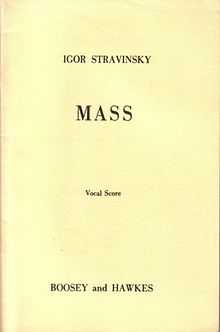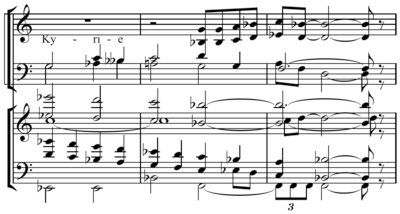Mass (Stravinsky)

Igor Stravinsky composed his Mass between 1944 and 1948. This 19-minute setting of the Roman Catholic Mass exhibits the austere, Neoclassic, anti-Romantic aesthetic that characterizes his work from about 1923 to 1951. The Mass also represents one of only a handful of extant pieces by Stravinsky that was not commissioned. As such, part of the motivation behind its composition has been cited by Robert Craft and others as the product of a spiritual necessity.
History
My Mass was partly provoked by some Masses of Mozart that I found at a secondhand store in Los Angeles in 1942 or 1943. As I played through these rococo-operatic sweets-of-sin, I knew I had to write a Mass of my own, but a real one.— Igor Stravinsky to Robert Craft[1]
Stravinsky completed the Gloria on December 20, 1944 and finished the Kyrie at about the same time. His work on the Mass was then interrupted for several years in which his wrote his Symphony, Ebony Concerto, Concerto in D, and the ballet Orpheus. He resumed work on it in the fall of 1947 and completed it March 15, 1948.
On February 26, 1947, Irving Fine conducted the Kyrie and Gloria, accompanied by two pianos. The first complete performance occurred on October 27, 1948 in Milan. Ernest Ansermet conducted members of the chorus and orchestra of La Scala.
Orchestration
The work is scored for mixed chorus and an ensemble of wind instruments comprising two oboes, English horn (Cor anglais), two bassoons, two trumpets, and three trombones. There is also some minor solo material (often sung by members of the choir) in the second and fourth (Gloria and Sanctus) movements. Stravinsky specifies in the score that "children's voices should be employed" for both the soprano and alto parts, but, as with Stravinsky's Symphony of Psalms, concert performances of the Mass usually employ adult singers.
Structure

Like his 1955 work Canticum Sacrum, the Mass forms a symmetrical plan on a large-scale. The outer movements (the Kyrie and the Agnus Dei) contain homophonic choral statements with instrumental interludes, and share a tonal vocabulary including octatonic, diatonic, and modal scales. By contrast, movements 2 and 4 (the Gloria and the Sanctus) feature florid solo lines which alternate with the choral statements, and the harmony is more recognizably and consistently diatonic.[3] The central movement, the Credo, is the longest. It features static, syllabic, and declamatory text-setting with a limited harmonic and rhythmic vocabulary. Long stretches of text often repeat a single chord, evoking the reciting tone of Gregorian chant or the Orthodox liturgical chant that Stravinsky would have known from his childhood in Saint Petersburg. Clear setting of the text is favored over an expressive interpretation of its meaning.[3] The music features examples of polyvalency.[2]
Faith
Stravinsky chose to compose this Roman Catholic Mass despite his own Orthodox faith. He stated that this was because:
- “I wanted my Mass to be used liturgically, an outright impossibility as far as the Russian Church was concerned, as Orthodox tradition proscribes musical instruments in its services- and as I can endure unaccompanied singing in only the most harmonically primitive music.”[4]
Stravinsky also said of the Credo:
- “One composes a march to facilitate marching men, so with my Credo I hope to provide an aid to the text. The Credo is the longest movement. There is much to believe.”[4]
References
- ↑ Eric Walter White, Stravinsky: The Composer and his Works. London and Boston: Faber and Faber, 1979: p. 407.
- ↑ 2.0 2.1 Leeuw, Ton de (2005). Music of the Twentieth Century, p.88. ISBN 90-5356-765-8.
- ↑ 3.0 3.1 Edward Lundergan. "Modal Symmetry and Textural Symbolism in the Credo of the Stravinsky Mass. Choral Journal 45, no. 8 (March 2006): 9.
- ↑ 4.0 4.1 Michael Steinberg. "Igor Stavinsky: Mass." Choral Masterworks: A Listener's Guide. Oxford: Oxford University Press, 2005, 272.
| ||||||||||||||||||||||||||||||||||